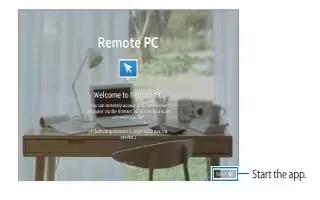Learn how to remote PC on your Samsung Galaxy Tab S. Use this app to view and control your computers screen on your device by connecting your device and computer via a Wi-Fi or local area network. You can also easily view and transfer files between your device and computer.
Before using this app
- Ensure that you have a registered Samsung account.
- Ensure that the computer is turned on.
- Ensure that the Agent is installed on your computer.
- To use this feature, perform the following in numerical order:
- Register the device with your Samsung account.
- Register the computer with your Samsung account.
- Remotely connect the device and the computer.
Registering the device

- On your device, tap Remote PC on the Apps screen.
- Tap Next on the greeting page.
- Tap Sign in, enter your Samsung account and password, and then tap Sign in again. If a Samsung account is not registered, follow the on-screen instructions to create a Samsung account.
Registering a computer

- On your computer, launch the web browser and visit “remotepc.”
- Sign in to your Samsung account. You must sign in to the same Samsung account that you use on your device.
- Install the Agent if it is not installed on your computer. Follow the on-screen instructions to enter a display name for the computer, proxy settings, and password. For more information about proxy server settings, contact your network administrator. Remote PC icon will appear on the task bar when the installation is completed.
- Tap Check Connection (Refresh).
Connecting the device and a computer remotely

- Tap Remote PC on the Apps screen.
- Tap Check Connection (Refresh).
- Tap ON computer.
- Enter the password for the connection and tap OK.
Note: Tap Forgotten your password? if you do not remember the password.
- The connection is made and you can control the computer remotely on the device.
Controlling the computer on the device
- After connecting the devices, you can view and control your computers screen on the device. You can also open or edit files in the computer and transfer them to the device.

- Tap the screen and tap . . . icon at the bottom of the screen to use one of the following:

- Mouse: Display the mouse pointer on the devices screen.
- Keyboard: Open the keyboard to enter text in the selected text field.
- Remote Explorer: Open the file manager to search for files and transfer files between the connected devices.
- Switch Window: Switch between two monitors when the computer is connected to dual monitors.
- Close: Close the currently-running app.
- More:
- Screen lock: Lock the devices screen to disable the zoom and scroll functions.
- Settings: Change the connection settings.
- Ctrl + Alt + Delete: Open the task manager on your computer.
- Disconnect: Close the connection between the device and the computer.
Transferring files between your device and the computer
- Tap . . . icon > Remote Explorer.
- Tap and hold a file on the computers file manager panel. Then, drag it to the devices file manager panel. You can also move a file vice versa.
Disconnecting the device and a computer

- On your device, tap Back Key OK.
- On your computer, right click remote PC icon on the task bar and exit the Agent programme.
Note
This guide will work on all Samsung Galaxy Tab S’s; including Samsung Galaxy Tab S 8.4 and Samsung Galaxy Tab S 10.5.
